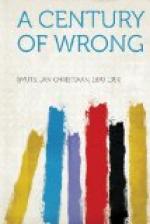But no reliance could be placed on England’s word, even though it was embodied in a Convention duly signed and ratified, for when the Diamond Fields were discovered, barely seventeen years later, England claimed a portion of Transvaal territory next to that part which had already been wrested from the Free State. Arbitration was decided upon. As the Arbitrators could not agree, the Umpire, Governor Keate, gave judgment against the Transvaal. Thereupon it appeared that the English Arbitrator had bought 12,000 morgen (of the ground in dispute) from the Native Chief Waterboer for a mere song, and also that Governor Keate had accepted Waterboer as a British subject, which was contrary to the Convention. Even Dr. Moffat, who was no friend of the Boers, entered a protest in a letter to the Times, on the ground that the territory in question had all along been the property of the Transvaal.
[Sidenote: Sale of guns to Natives.]
But this was only one of the breaches of the Convention. When the 400,000 guns, about which Cunynghame and Moodie testify, were sold to the Kaffirs, the Transvaal lodged a strong protest in 1872 with the Cape High Commissioner. Their only satisfaction was an insolent reply from Sir Henry Barkly.
[Sidenote: Annexation of the Transvaal.]
As a crowning act in these deeds of shame came the Annexation of the Transvaal by Shepstone on the 12th April, 1877. Sir Bartle Frere was sent out as Governor to Cape Town by Lord Carnarvon to carry out the confederation policy of the latter. Shepstone was also sent to the Transvaal to annex that State, in case the consent of the Volksraad or that of the majority of the inhabitants could be obtained. The Volksraad protested against the Annexation. The President protested. Out of a possible 8,000 burghers, 6,800 protested. But all in vain.
Bishop Colenso declared that: [25] “The sly and underhand way in which the Transvaal has been annexed appears to be unworthy of the English name.”
The Free State recorded its deepest regret at the Annexation.
Even Gladstone, in expressing his regret, admitted that England had in the Transvaal acted in such a way as to use the free subjects of a kingdom to oppress the free subjects of a Republic, and to compel them to accept a citizenship which they did not wish to have.
But it was all of no avail.
Sir Garnet Wolseley declared: “As long as the sun shines the Transvaal will remain British Territory.” He also stated that the Vaal River would flow backwards to its source over the Drakensberg before England would give up the Transvaal.
[Sidenote: Pretexts for the Annexation.]
Shepstone’s chief pretexts for the Annexation were that the Transvaal could not subdue Secoecoeni, and that the Zulus threatened to overpower the Transvaal. As far as Secoecoeni is concerned, he had shortly before sued for peace, and the Transvaal Republic had fined him 2,000 head of cattle. With regard to the Zulus, the threatened danger was never felt by the Republic. Four hundred burghers had crushed the Zulu power in 1838, and the burghers had crowned Panda, Cetewayo’s father, in 1840.




